#psychologists find themselves doing harm reduction math WAY too much
Explore tagged Tumblr posts
Text
Well, I was hoping enough time had passed, but I guess Dream is still having his episode. There doesn't really seem to be a good time. I have something to say, though.
EDIT: I did not clarify something in this post that needs to be clarified. Dream is being irresponsible by not seeking help. However, anyone would be resistant to seek help for this because of social stigma. The notes on this post are proving my point. Every behavior has a cause. Abuse is a circle that takes effort to break. That is the point of this post. No one is "just a bad person." That mentality literally kills people.
I maintain the belief that Dream has Narcissist Personality Disorder. Beneath the cut is the diagnostic outline from the DSM-5 so that you can draw your own conclusions. To be clear, I am not yet a licensed psychologist, so this is just my opinion.
Dream seems to be declining help, or he is under the belief that he does not need help. Personality disorders can be debilitating; they affect your relationships, work ethic, and ability to cope with basic life stressors. He needs to see a cognitive-behavioral therapist so that he can begin to learn coping strategies.
Moreso, however, I wanted to talk about self-diagnosis. I do not believe that Dream has autism. I can make a separate post with the Autism Spectrum Disorder diagnosis if people are interested. (I do have a physical copy of the DSM-5 because I need it for school, but the full PDF is also available online if you're interested in looking through it.) I do not believe that Dream was professionally diagnosed. This is because psychologists no longer diagnose autism based on how much your symptoms align with the definition, but rather how much support you need in your everyday life. For example, I would never personally diagnose somebody with ASD unless they were seeking work or school accommodations.
Diagnosing yourself can be challenging if you do not have a broad understanding of other disorders. Just because you struggle to socialize with others does not mean you have autism. There are a myriad of other disorders it could be, and the correct diagnosis is crucial. This also goes for diagnoses such as depression or anxiety, as they could be symptoms of something else.
Another thing I want to point out is that Dream last saw a psychiatrist to be diagnosed with ADHD when he was about 12—if I remember correctly. However, our brains are constantly developing throughout life. Narcissistic Personality Disorder cannot be accurately diagnosed in teenagers. (Is this teenager a narcissist or are they just experiencing personal fable, something completely normal and expected at this age?) I point this out because it's important for everyone with a brain to understand that you can progressively develop a mental illness without even realizing it. You don't particularly notice that you have a personality disorder—or most disorders that aren't depression or anxiety. Bipolar Disorder on average develops around the age of 16. Schizophrenia develops on average around the ages of 18-25. (Childhood Schizophrenia does exist, however it is so rare that it has really only been observed in case studies.)
Narcissistic Personality Disorder is not a diagnosis you can medicate—or any personality disorder, at that. One would need to take several years to learn coping strategies that may involve things as simple as app timers to as complex as perspective-taking strategies. However, this is one of the more difficult personality disorders to cope with, and certainly not one you would want to manage alone. Dream sincerely needs help.
Even if Dream does get help, it is important to know that the people he has hurt have no obligation to come back into his life, nor do they have an obligation to help him when they do not have any education or training in the field. I need those you have someone in their lives who may be struggling with this diagnosis to understand that. You do not owe anyone anything. You are not responsible for anyone, because you lack the training and education to do it. I am spending 10 years of my life in college right now trying to learn how to help these people. Please understand that it is okay to step away without guilt.
Anyway, I said my piece. Please stop calling people narcissists like it's a slur. There are real people that have this disorder that are trying to cope and maintain healthy relationships. It is possible. These people are not doomed. However, it is heartbreaking to watch someone who clearly needs help and guidance but refuses to seek it.
As promised, here is the diagnostic outline for Narcissistic Personality Disorder:
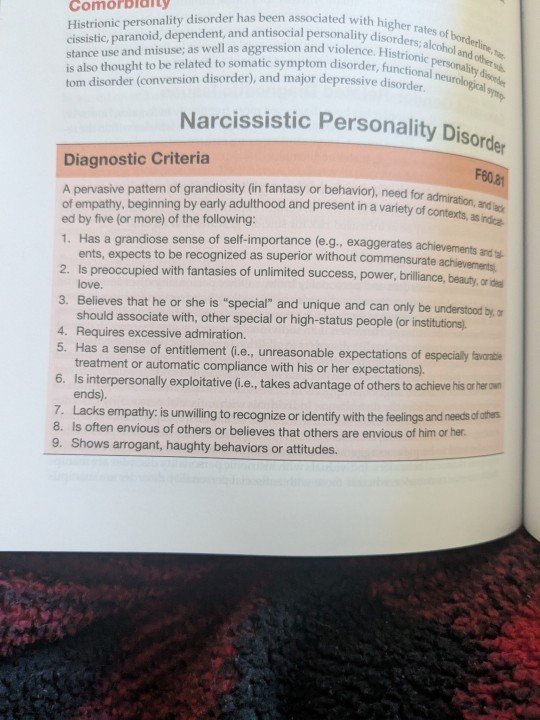
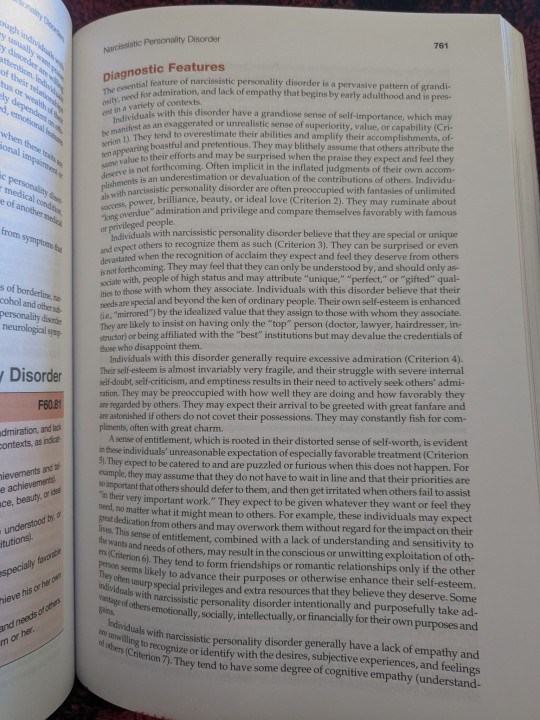
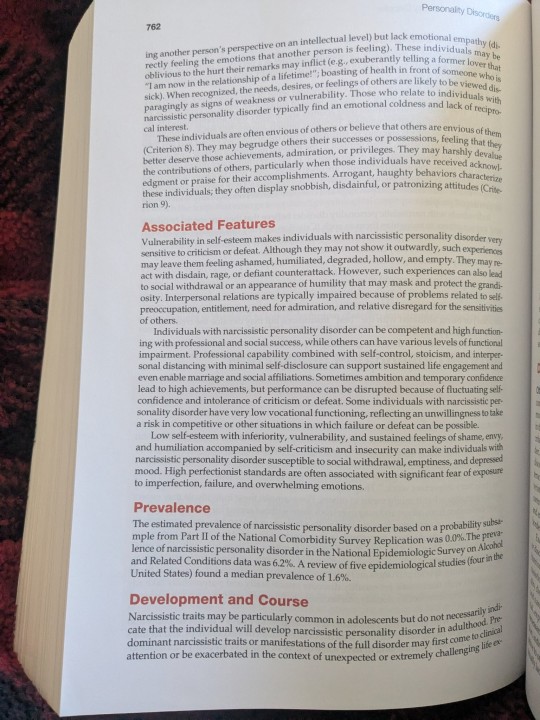
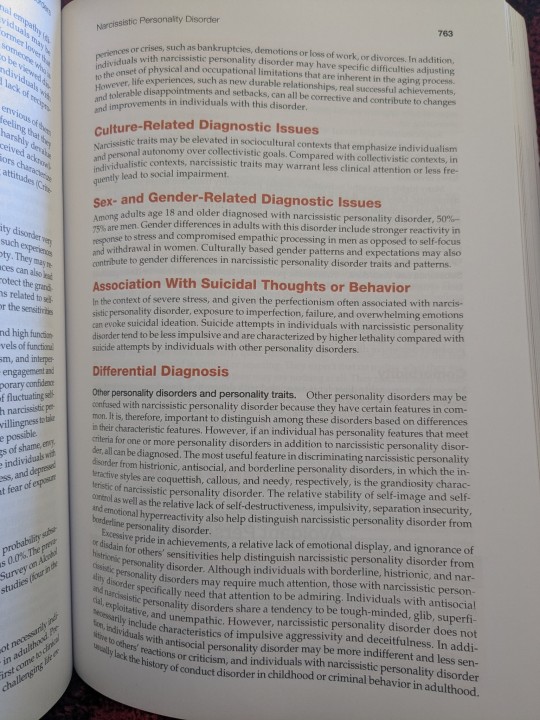
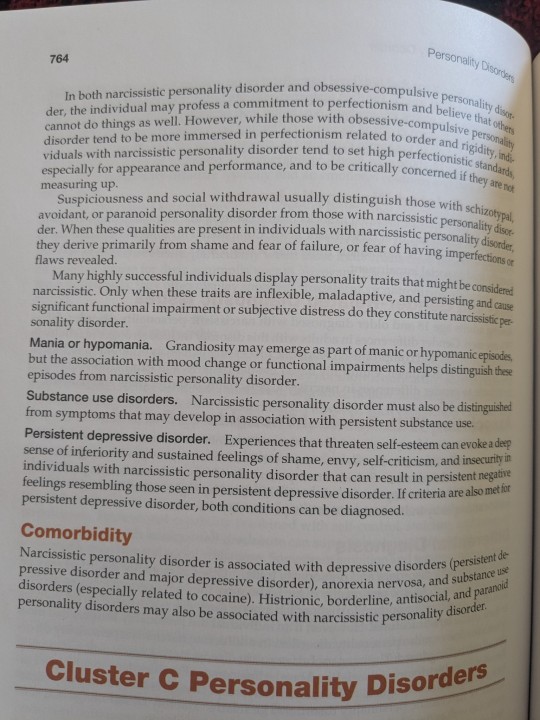
#i also am of the opinion that he has a bipolar disorder#but that one is harder to talk about because i do not see his everyday life#but back when he was tweeting consistently and uploading more it was much more obvious#to me anyway#it seems that this manic episode has psychotic features#which is to say that he desperately needs help because that can get dangerous for him#ive seen some people compare him to gabbie hannah#i do wonder how shes doing#but yeah yknow shit got real when she let a stranger into her house#thank god he didnt hurt her but man#this is real life with real people#and you will meet and love people who struggle with these things#people only want to spread awareness about disorders that are easy to understand#and i have a bit of a problem with that#its a little contradictory isnt it#anyway#thoughts of dante#dream#classes start next week for me and ill be back to child development#so get ready for my parenting hot takes despite me never having a child in my possession before#ALSO#i want to clarify that autism diagnosis point#some psychologists hesitate to diagnose autism even if you do need accommodations because the diagnosis itself can be a job killer#which is why raising awareness about how broad the spectrum is is very important#but if youve ever struggled to get diagnosed#its not even ableism from the psychologist (it could be there are very ableist freud lovers in this field)#its usually moreso ableism from society#psychologists find themselves doing harm reduction math WAY too much
11 notes
·
View notes
Text
15 Serious Facts about High School Stress
Every parent and educator must know these troubling facts about our teens. Each fact is a wake-up call, but together they should mean: “Time for Code Red”
This blog was written by the Bachelor’s Degree Online and published with its permission.
One of the greatest lies ever perpetuated about the teen years is that they’re supposedly “the best years of your life.” Ask any high schooler these days how he or she genuinely feels about this statement and the opposite sentiment might very well end up relayed instead.
Every year, more and more pressures regarding classes, getting into the right college (or deciding if college is even the right choice), families, jobs, extracurricular activities, friends, relationships, and other stimuli just keep burbling away beneath their still-developing forms.
Suffice it to say, this avalanche of stress hinders their progress and personalities far more than it helps, but many think they have no real alternative. Without persistently striving toward an unattainable perfection, students find themselves trapped between success or failure, with no “gray areas” in between.
And the situation worsens every year, although there are plenty of things administrators, teachers, parents, and even the teens themselves can to do promote calmness and balance. Before that, though, they should understand exactly what’s at stake when it comes to stress and anxiety in the high school classroom.

1. Most high school students consider cheating OK: According to a CNN poll of 4,500 high schoolers, around 75% engage in “serious cheating,” over half plagiarize directly from the Internet, and about 50% believe that copying answers doesn’t even count as cheating. Such questionable ethics apparently stem directly from absurd competition, since grades mean the difference between getting into a dream school and a backup. To alleviate the mounting stress to constantly perform at the highest level, students turn toward cheating and compromising their own education as a solution.
2. One in five teens qualifies as clinically depressed: According to Mental Health America’s estimates, 20% of teens are clinically depressed, and the real tragedy lies with how their parents and teachers approach the subject. Because so many dismiss the symptoms of depression as mere adolescent adjustments, a disconcerting number of these teens go without the treatment they need to enjoy a healthy, happy life.
Obviously, depression stems from numerous factors beyond just heightened academic pressures. But they certainly render already painful situations even worse, regardless of whether or not they exist as the root cause.
3. Stress ups the suicide rate…: Over in the UK, Oakgrove head teacher John Harkin told The Guardian that anywhere between 600 to 800 students between the ages of 15 and 24 commit suicide annually. A poll of 804 teachers revealed that 73% considered school (and life in general) far more stressful for students than in the previous decade, which more than likely contributes to the climbing suicide rate. Eighty-nine percent believed high-stakes classroom assignments and exams played a major (if not the premiere) role in nurturing anxiety.
4. …oh, and self-harm, too: Beyond suicide, though, British students also cause self-harm in greater numbers than before, correlating with the increase in school and other life pressures. As reported by The Guardian, 46% of polled teachers claimed they knew of kids in middle and high school harming themselves. Cutting seems to be the most popular trend beneath this tragic umbrella, although anorexia — which, by the way, has little to do with simply wanting to “be skinny” — and other eating disorders appear on the rise as well.
5. The same thing happens in the U.S., too: The problem of depression, anxiety and suicide transcends nationality, and The Almanac printed statistics from the National Institutes of Health and its study on random San Francisco students. Although obviously not indicative of the whole nation’s risk, it did highlight the relationship between stress and mental health taxing the youth. A staggering 30% of the city’s high schoolers suffered beneath a suicide risk, and one institution in particular (Menlo-Atherton High School) saw 40 teens forced to go under behavior monitoring within a year.
6. Some schools have purged the AP Program altogether…: Despite the prestige heaped onto offering Advanced Placement classes and harboring students who get stellar scores on the affiliated exams, some schools have decided to forgo them completely. These college-level courses taught in high school require a heftier workload than their level and honors counterparts, and institutions like Beaver Country Day School in Massachusetts don’t think the inflated stress is worth the emotional and physiological toll. So they’ve obliterated the program, which they claim has no impact whatsoever on graduates’ eventual college acceptance and success.
7. …and managed to implement some successful alternatives, too: Along with jettisoning the AP Program, some schools — like the aforementioned Beaver Country Day School — have decided to implement other measures to keep students from succumbing to stress. More low-key assignments, like shooting videos or writing songs, prove just as effective as more rote, lecture-based methods used in traditional classrooms. Other strategies include weekends with no homework assigned, improved communication between teachers so major exams don’t correspond with those in other classes, and longer study and recreation periods. Once again, the school reports that these strategies improve the quality of life for their students without compromising their academic performance or potential.
8. And the teachers on the front lines could be doing better as well: Regardless of whether or not they work in a school experimenting with more stress-reduction methods, teachers themselves could generally do better when nurturing mentally and emotionally healthy students, especially those teachers with Advanced Placement kiddos under their care. Menlo-Atherton High School math teacher Jerry Brodkey practices empathy in his classroom, tailoring his workloads to maximize education while minimizing anxiety. Such a simple concept and awareness of his students’ lives beyond his calculus and algebra classes resulted in improved scores once AP Exam time rolled around. Not to mention some seriously positive teacher evaluations mentioning how the relaxed atmosphere better facilitated learning and information retention.
9. It starts much earlier than high school: Increased college competition means increased high school competition. Increased high school competition means increased middle school competition. Increased middle school competition means increased elementary school competition. Once students get to the last four compulsory grades, the pressure to constantly excel and perform has already been shoved into their growing bodies. So when kids do succumb to the pressures, chances are they may very well have been lurking beneath the surface long before freshman year.
10. Female students feel it harder than their male peers: A survey conducted by the Associated Press and MTV discovered that of the 85% of students claiming they experienced “stress at least sometimes” (if not more than that), most were female. Forty-five percent reported they felt it “frequently,” compared to 32% of their male colleagues. Most disconcertingly, the trend seemed to reflect an increase in stress and anxiety levels when compared to surveys from the year before — at least 10 points higher, says MSNBC. Interestingly enough, students hailing from mid-range income families experienced far more pressure than those from low- or high-income ones.
11. Girls are more likely to suppress their stress: Not only are female students more likely to experience hefty amounts of stress, they also typically handle it more discreetly than males. However, the boys don’t always handle it healthily, either — according to Dr. Roni Cohen-Sandler, they typically react to the anxieties by dropping out mentally. Social pressures push girls towards constant perfection in school, extra-curriculars, appearances, relationships and friendships without ever growing ragged or showing signs of exhaustion (what sociologist Michael Kimmel refers to as “effortlessly perfect”). In fact, 55% told the psychologist they place almost unnecessary amounts of stress on themselves to maintain society’s near-impossible expectations of flawlessness.
12. School ranks as the highest stressor in high school students’ lives: For both females and males between the ages of 13 and 17, school stood as their primary conduit of super stress. Once they hit the 18-to-25-year-old demographic, work supplants academics. But high schoolers face down more anxieties than that, including (but not limited to) bullying, broken homes, substance abuse (or the temptation towards substance abuse), relationships and sex, jobs, extracurricular activities, appearances and more. Girls and young women in particular find themselves petrified for safety reasons at a higher rate than their male counterparts, as they’re more likely to be the victims of rape and sexual assault.
13. GPAs are increasing: In California, at least, where state schools saw a significant rise in the GPAs of incoming freshman between 2003 and 2009. Petaluma360.com’s Colleen Rustad noted that UC Davis transitioned from a 3.86 to a 4.0 average, and Berkeley witnessed an increase from 3.58 to 3.61. So while some modicum of positivity can be squeezed out of the overworked teenagers’ plight, the serious mental and physical health tolls often render them a rather Pyrrhic victory instead.
14. Parents can exacerbate the situation…: Even the most well-meaning, loving moms and dads (or grandparents or aunts or uncles or legal guardians) run the risk of contributing to Little Junior or Muffy’s ever-mounting anxiety. Although parents and guardians should encourage and support their kids’ academic and (within reason) personal goals, they should stay alert for signs of burnout as well. Success (ethically earned, of course) is always great, but should never take precedence over the health, safety and overall well-being of a student, either. The likelihood of entering an Ivy League university even with a perfect record sits between 7% and 18%, and there’s no shame in pointing kids toward more affordable — and still thoroughly viable — options requiring less strenuous high schooling.
15. …but they’re also key in making it better: Dr. Cohen-Sandler’s research revealed that less than 50% of the most stressed-out female students believed their parents and guardians didn’t notice the mental and physical cracks forming. Along with “less stress” and “more sleep,” the primary thing this demographic desires is more communication and support from parents and guardians. They believe bouncing their feelings off a more experienced individual who knows them well will prove game-changing in better managing their time, emotions, friendships, and other messy hallmarks of being a teen. In addition, tighter-knit, more genuine social circles and the eradication of “mean girls” will considerably help ease the transition into adulthood.
0 notes